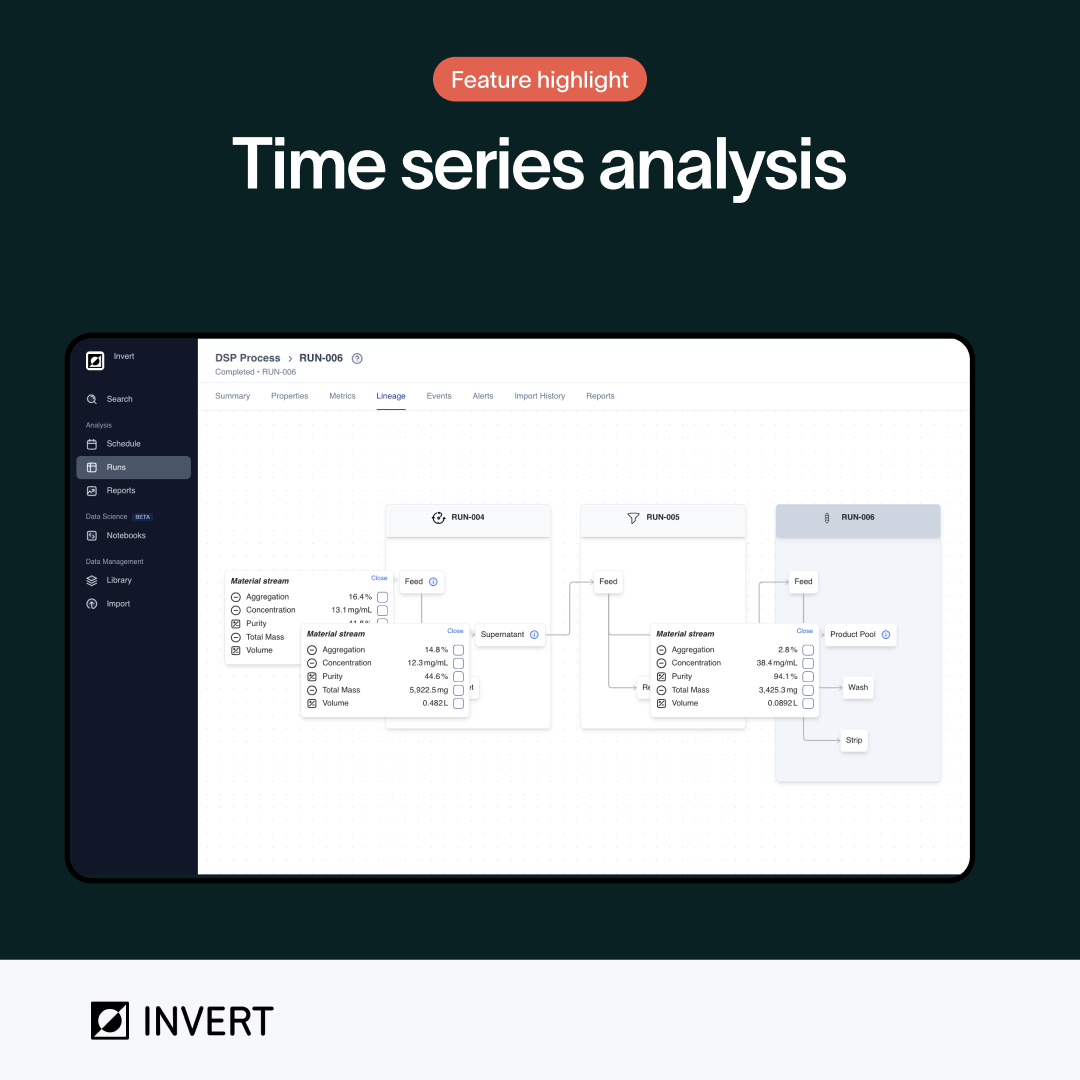How to Scale Up Bioprocess Manufacturing Without the Data Headaches

Scaling Up: The Moment Where Promise Meets Pressure
In bioprocess development, scale-up is where science meets production reality. A process that performs beautifully in a 5-liter bioreactor can behave very differently at 500 or 5,000 liters. Oxygen transfer, shear stress, nutrient gradients, and subtle timing differences can all shift results.
Getting this transition right is the difference between a successful therapy launch and costly delays. Yet the work of scaling a process remains burdened by the same obstacle that slows so many teams: fragmented data.
From development to pilot to manufacturing, data is spread across systems, sites, and partners. Each step introduces new formats, naming conventions, and blind spots. The more you scale, the more complexity compounds.
That’s why modern biomanufacturers are turning to AI-powered bioprocess scale-up software—platforms built to unify live data, automate insight generation, and simplify the path from development to production.
Why Scale-Up Is So Data-Intensive
Scaling up isn’t just about bigger tanks. It’s about understanding how thousands of variables interact as volumes grow. Each batch generates gigabytes of time-series data from sensors, probes, and control systems. Add in analytics from chromatography, metabolite assays, and CDMO data, and the result is an overwhelming amount of information.
Traditional spreadsheets and static dashboards cannot keep up with this level of complexity. Scientists spend days cleaning and stitching together data just to perform a single comparison. By the time they spot an anomaly, the run is over and the opportunity to correct it is gone.
The bottleneck isn’t the science—it’s the data workflow.
The Role of AI in Modern Scale-Up
Artificial intelligence helps teams move faster by transforming raw data into usable insight in real time. Instead of waiting for end-of-run reports, scientists can visualize performance as it happens, identify deviations early, and predict which parameters will affect yield or quality.
AI models learn from historical and live process data to recommend adjustments that improve scalability and consistency. They also flag risks that might compromise cell viability or product potency, long before they turn into failed batches.
When built on a trusted, harmonized data foundation, these models deliver insights that are not only fast but reliable and compliant.
How AI-Driven Scale-Up Platforms Work
A modern bioprocess scale-up platform combines several key functions into one connected environment:
- Unified Data Layer
The software automatically ingests and harmonizes data from instruments, control systems, and CDMOs. Parameters, units, and timestamps are standardized so every data point is comparable across experiments and facilities. - Real-Time Visualization
Scientists and engineers can monitor critical process parameters live, catching issues such as oxygen limitation or pH drift immediately rather than hours later. - AI-Powered Analytics
Machine learning models analyze patterns across historical runs to reveal relationships between scale, feed strategy, and performance. The insights are presented transparently so users can understand why the model recommends a particular change. - Collaboration and Traceability
Centralized, contextualized data ensures that everyone—from process development to manufacturing and quality—works from the same source of truth. This traceability is essential for regulatory readiness and successful tech transfer.
Invert’s Bioprocess AI Software integrates all of these capabilities in a single system. Designed by experts who have lived both bioprocess and technology, Invert gives teams the live visibility they need to scale faster with confidence.
Case in Point: Cell Therapy Manufacturing
Cell therapy exemplifies the complexity of modern bioprocess scale-up. Each therapy involves living cells that respond dynamically to subtle environmental changes. Traditional batch-based monitoring cannot capture this nuance.
With an AI-driven intelligence layer, teams can track culture conditions in real time, compare donor-to-donor variability, and adjust feeding or oxygenation strategies before quality drifts occur. Harmonized data also makes tech transfer smoother between development labs, CMOs, and manufacturing suites.
For startups entering clinical or commercial production, this capability can mean the difference between a successful tech transfer and months of troubleshooting.
Benefits of AI-Powered Scale-Up Software
- Shorter time to milestone: Faster analysis means quicker learning cycles and reduced experimental repetition.
- Improved yield and consistency: Predictive analytics identify the process settings that deliver optimal performance at each scale.
- Lower cost and risk: Early detection of process deviations prevents wasted batches and rework.
- Simplified compliance: Harmonized, traceable data makes it easier to demonstrate control and validation.
- Faster collaboration: Scientists, engineers, and quality teams can access live, shared data through one platform instead of relying on email and spreadsheets.
Organizations that have adopted AI-driven scale-up intelligence consistently report fewer failed runs and faster transfer from pilot to GMP production.
The Future of Scale-Up: Connected and Continuous
The next evolution of bioprocess manufacturing will be defined by connected data pipelines and continuous learning systems. As AI models mature, they will not only predict performance but automatically adjust parameters within validated boundaries.
This future depends on building a strong data foundation today. Companies that invest in harmonized, AI-ready data will be positioned to take advantage of advanced capabilities such as digital twins, real-time optimization, and autonomous control.
Platforms like Invert are enabling this transformation by turning complex process data into clear, actionable intelligence that bridges development and manufacturing.
Ready to Scale Without the Headaches?
Scaling bioprocesses no longer has to mean scaling your data problems. With an AI-powered foundation and live intelligence layer, your teams can move faster, make better decisions, and focus on science rather than spreadsheets.
Learn how Invert’s Bioprocess AI Software helps biotech and pharma organizations unify their data, streamline scale-up, and achieve milestones sooner.
Book a demo to see scale-up in action.
.png)
Engineer Blog Series: From Bioprocess to Software with Anthony Quach
Welcome to Invert’s Engineer Blog Series — a behind-the-scenes look at the product and how it’s built.In this post, software engineer Anthony Quach shares how his career in bioprocess development led him into software, and how that experience shapes the engineering decisions behind Invert.
Read More ↗
Connecting Shake Flask to Final Product with Lineage Views in Invert
Invert’s lineage view connects products across every unit operation and material transfer throughout the entire process. It acts as a family tree for your product, tracing its origins back through purification, fermentation, and inoculation. Instead of manually tracking down the source of each data point, lineages automatically show material streams as they pass through each step.
Read More ↗
Engineer Blog Series: Security & Compliance with Tiffany Huang
Welcome to Invert's Engineering Blog Series, a behind-the-scenes look into the product and how it's built. For our third post, senior software engineer Tiffany Huang speaks about how trust and security is a foundational principle at Invert, and how we ensure that data is kept secure, private, and compliant with industry regulations.
Read More ↗